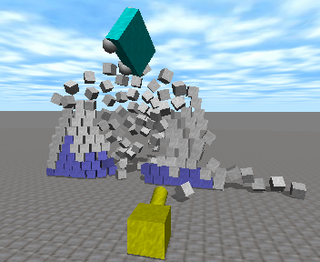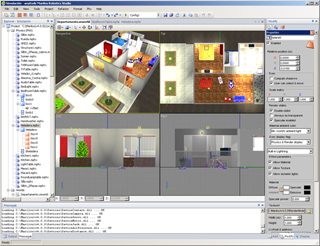
A simulation is an imitative representation of a process or system that could exist in the real world. In this broad sense, simulation can often be used interchangeably with model. Sometimes a clear distinction between the two terms is made, in which simulations require the use of models; the model represents the key characteristics or behaviors of the selected system or process, whereas the simulation represents the evolution of the model over time. Another way to distinguish between the terms is to define simulation as experimentation with the help of a model. This definition includes time-independent simulations. Often, computers are used to execute the simulation.

Computer simulation is the running of a mathematical model on a computer, the model being designed to represent the behaviour of, or the outcome of, a real-world or physical system. The reliability of some mathematical models can be determined by comparing their results to the real-world outcomes they aim to predict. Computer simulations have become a useful tool for the mathematical modeling of many natural systems in physics, astrophysics, climatology, chemistry, biology and manufacturing, as well as human systems in economics, psychology, social science, health care and engineering. Simulation of a system is represented as the running of the system's model. It can be used to explore and gain new insights into new technology and to estimate the performance of systems too complex for analytical solutions.

The Open Dynamics Engine (ODE) is a physics engine written in C/C++. Its two main components are a rigid body dynamics simulation engine and a collision detection engine. It is free software licensed both under the BSD license and the LGPL.
SIMNET was a wide area network with vehicle simulators and displays for real-time distributed combat simulation: tanks, helicopters and airplanes in a virtual battlefield. SIMNET was developed for and used by the United States military. SIMNET development began in the mid-1980s, was fielded starting in 1987, and was used for training until successor programs came online well into the 1990s.

A mining simulator is a type of simulation used for entertainment as well as in training purposes for mining companies. These simulators replicate elements of real-world mining operations on surrounding screens displaying three-dimensional imagery, motion platforms, and scale models of typical and atypical mining environments and machinery. The results of the simulations can provide useful information in the form of greater competence in on-site safety, which can lead to greater efficiency and decreased risk of accidents.
Hardware-in-the-loop (HIL) simulation, also known by various acronyms such as HiL, HITL, and HWIL, is a technique that is used in the development and testing of complex real-time embedded systems. HIL simulation provides an effective testing platform by adding the complexity of the process-actuator system, known as a plant, to the test platform. The complexity of the plant under control is included in testing and development by adding a mathematical representation of all related dynamic systems. These mathematical representations are referred to as the "plant simulation". The embedded system to be tested interacts with this plant simulation.
Dynamic simulation is the use of a computer program to model the time-varying behavior of a dynamical system. The systems are typically described by ordinary differential equations or partial differential equations. A simulation run solves the state-equation system to find the behavior of the state variables over a specified period of time. The equation is solved through numerical integration methods to produce the transient behavior of the state variables. Simulation of dynamic systems predicts the values of model-system state variables, as they are determined by the past state values. This relationship is found by creating a model of the system.
MIMIC Simulator is a product suite from Gambit Communications consisting of simulation software in the network and systems management space.

Webots is a free and open-source 3D robot simulator used in industry, education and research.

A robotics simulator is a simulator used to create an application for a physical robot without depending on the physical machine, thus saving cost and time. In some case, such applications can be transferred onto a physical robot without modification.

anyKode Marilou is a modeling and simulation environment for mobile robots, humanoids, articulated arms and parallel robots operating in real-world conditions that respect the laws of physics. This robotics suite is used in research centers and industry for various projects like humanoid architectures, wheeled and multi legged vehicles, and multi-robot systems (Multi-agents).

In computing, an emulator is hardware or software that enables one computer system to behave like another computer system. An emulator typically enables the host system to run software or use peripheral devices designed for the guest system. Emulation refers to the ability of a computer program in an electronic device to emulate another program or device.
AGX Dynamics is a proprietary real-time physics engine developed by Algoryx Simulation AB that simulates rigid body dynamics, collision detection, dry frictional contacts, jointed systems, motors, fluids, deformable materials, hydraulics, hydrodynamics, cable systems and wires. AGX targets several domains, such as virtual reality real-time simulator applications for training and marketing; computer aided engineering and virtual prototyping; movie visual effects; and education. For education, components of AGX are used in the end-user software product Algodoo also developed and sold by Algoryx. Users of AGX simulate e.g. granular systems, construction equipment, forestry machines, mining processes and machines, biomechanics, industrial robots, ship and anchor handling processes and cranes. AGX is often integrated with 3D visualization frameworks such as OpenSceneGraph, OGRE, Unity and Unreal Engine and often also with actual hardware and control systems of the real-world version of the simulator. AGX is integrated in many 3D modeling and CAD systems, including Algoryx Momentum for ANSYS Discovery.

ECA-Sindel was an Italian company operating worldwide in the designing, manufacturing, installation, and maintenance of professional tactical and operational naval simulators. ECA -Sindel also produced integrated systems for training purposes in joint warfare operations by land, sea and air, called "Joint Warfare Simulators".

Astronaut training describes the complex process of preparing astronauts in regions around the world for their space missions before, during and after the flight, which includes medical tests, physical training, extra-vehicular activity (EVA) training, wilderness survival training, water survival training, robotics training, procedure training, rehabilitation process, as well as training on experiments they will accomplish during their stay in space.
AnimatLab is an open-source neuromechanical simulation tool that allows authors to easily build and test biomechanical models and the neural networks that control them to produce behaviors. Users can construct neural models of varied level of details, 3D mechanical models of triangle meshes, and use muscles, motors, receptive fields, stretch sensors and other transducers to interface the two systems. Experiments can be run in which various stimuli are applied and data is recorded, making it a useful tool for computational neuroscience. The software can also be used to model biomimetic robotic systems.
CM Labs Simulations is a private company established in Montreal in 2001. CM Labs is the developer of the Vortex simulation platform. The Vortex platform is composed of applications for creating interactive vehicle and mechanical equipment simulations in virtual environments. Vortex simulates rigid body dynamics, collision detection, contact determination, and dynamic reactions. CM Labs also manufactures crane and heavy equipment simulators based on Vortex technology.
Gazebo is an open-source 2D/3D robotics simulator that began development in 2002. In 2017, development forked into two versions, known as "Gazebo", the original monolithic architecture, and "Ignition", which had moved to becoming a modernized collection of loosely coupled libraries. Following a trademark obstacle in 2022 regarding their use of the name "Ignition", Open Robotics took the opportunity to switch the version names, dubbing the original fork "Gazebo Classic" and the new, modern fork "Gazebo".

rFpro, originally rFactor Pro, is a driving simulation software used by racing teams and car manufacturers for advanced driver-assistance systems, self-driving cars and vehicle dynamics. rFactor Pro was created in 2007 as a project of a F1 racing team, using Image Space Incorporated's rFactor as a codebase. It has since been used by more F1 racing teams, top road car OEMs, Tier 1 suppliers, and motorsport manufacturers. It was originally developed for driver-in-the-Loop simulations, but has since been used for autonomous vehicle training as well. It is not licensed to consumers.










